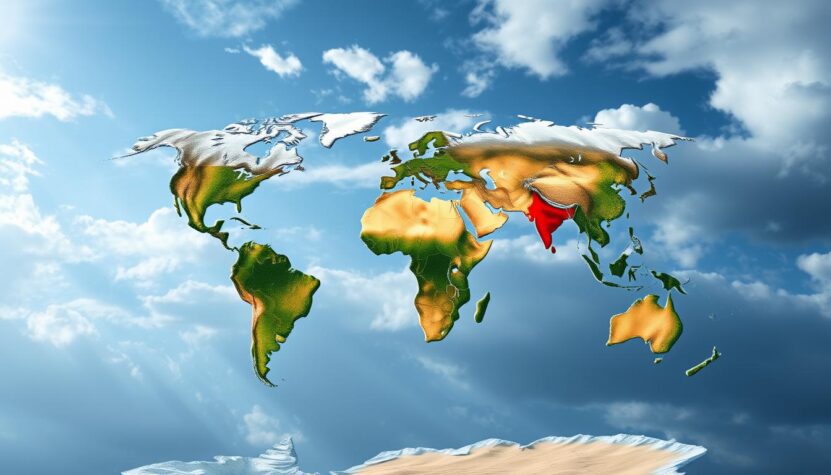Latitude is a fundamental geographical element that profoundly influences the climate experienced in various regions around the globe. By understanding how latitude affects climate, you can gain insights into the unique characteristics of different areas, ranging from the humid tropics near the equator to the icy expanses of the polar regions. The Earth’s climate zones, dividing the globe into tropical, temperate, and polar sections, provide a framework for understanding these significant climatic variations.
As you explore the concept of latitude, you’ll discover that it is measured in degrees north or south of the equator, which sits at 0° latitude. The Tropics, located at approximately 23.5° N (Tropic of Cancer) and 23.5° S (Tropic of Capricorn), represent the regions that experience the most direct sunlight, while the poles, at 90° N and 90° S, endure the least. With over 2,000 mm of rainfall annually in tropical regions compared to less than 250 mm in polar areas, it’s clear that latitude and climate are intimately connected.
In this article, you’ll delve into how latitude shapes the climate, affecting everything from temperature and rainfall patterns to seasonal variations and biodiversity. Moreover, you’ll learn about the implications of climate change across these diverse zones, offering a comprehensive view of how latitude influences life on Earth. Understanding these patterns is crucial, especially in a time when rapid environmental changes pose unprecedented challenges to our planet.
What Is Latitude?
Latitude serves as a critical geographic coordinate, playing a vital role in our understanding of the Earth’s climate and geography. The concept revolves around the distance of a location from the equator, which is marked at 0° latitude. This coordinate system helps you comprehend how the positioning of various locations across the globe impacts weather patterns, climate types, and seasonal variations.
Definition of Latitude
The definition of latitude is anchored in its role as a measurement of how far north or south a location is from the equator. This measurement ranges from 0° at the equator to 90° at the poles. Locations nearer to the equator generally experience warmer and more humid conditions, while places positioned at high latitudes, like the North and South Poles, tend to be colder and drier. The establishment of parallels, which are imaginary lines that run parallel to the equator, facilitates a better classification of different latitude zones and their corresponding climates.
Measuring Latitude
Measuring latitude involves utilizing various tools and methods, including GPS technology, sextants, and geographic information systems. By determining angular positions in degrees, this process helps delineate how each geographical location interacts with surrounding environmental factors. For instance, the latitude of a region can significantly influence local climate and ocean currents. Areas at higher latitudes often experience pronounced seasonal shifts, with warm summers and harsh winters, while equatorial locations maintain consistent temperatures and daylight throughout the year.
Importance of Latitude in Geography
The importance of latitude in geography cannot be overstated, as it fundamentally affects climate patterns, biodiversity, and human activities. Variations in latitude control temperature ranges, precipitation levels, and seasonal dynamics. Coastal regions, for example, experience milder conditions compared to inland areas, while tropical zones receive ample rainfall due to prevailing low-pressure systems. Understanding latitude allows geographers and environmental scientists to predict climate behavior, promote effective land use, and enhance navigation.
| Latitude Zone | Climate Characteristics | Temperature Range | Precipitation Patterns |
|---|---|---|---|
| Tropical | Warm and humid | Consistent throughout the year | High precipitation |
| Temperate | Varied seasons | Moderate range | Moderate to high precipitation |
| Polar | Cold and dry | Cold with harsh winters | Low precipitation |
Latitude and Solar Energy
The relationship between latitude and solar energy is essential for understanding how sunlight impacts climate and temperature. Variations in latitude directly influence the amount of solar energy received in different regions, largely due to how the Earth’s curvature affects sunlight. Areas near the equator receive sunlight more directly, leading to higher temperatures and greater solar energy. In contrast, regions at higher latitudes experience sunlight at a steeper angle, resulting in reduced intensity of sunlight across latitudes and cooler climates.
Impact of Earth’s Curvature on Sunlight
As the Earth is spherical, its curvature plays a significant role in how sunlight reaches various locations. Near the equator, solar rays strike the surface more directly, maximizing the energy received. Conversely, in higher latitudes, sunlight has to penetrate a larger volume of atmosphere, diminishing its intensity. This phenomenon demonstrates how Earth’s shape influences climate conditions. For example, cities like Miami receive ample solar energy throughout the year compared to locations at 60°N, which endure longer winters due to less direct solar exposure.
Intensity of Sunlight Across Latitudes
The intensity of sunlight varies considerably across latitudes, affecting surface temperatures significantly. Data show that cities like Denver, at 40° latitude, receive significantly more solar energy in June than in December. This disparity underscores how varying angles of incoming solar radiation contribute to seasonal temperature fluctuations. In addition, the surface skin temperature data highlights that even locations at similar latitudes can exhibit temperature variations driven by factors such as elevation and moisture levels. Understanding these patterns aids in grasping the complex interactions between solar energy and Earth’s climate systems.
| Location | Latitude | Average Solar Energy (kWh/m²/month) | Average Temperature (°C) |
|---|---|---|---|
| Miami | 25.76° N | 200 | 24 |
| Denver | 39.74° N | 150 (June) / 50 (December) | 27 (June) / -3 (December) |
| Tokyo | 35.68° N | 170 | 20 |
| Detroit | 42.33° N | 120 | 15 |
How Does Latitude Affect Climate Zones?
Latitude plays a crucial role in defining climate zones by latitude, influencing temperature, precipitation, and seasonal variations. The Earth’s surface presents distinct climatic regions based on their distance from the equator, showcasing a diverse range of conditions. This section delves into the characteristics of these zones: tropical, temperate, and polar.
Tropical Zone Characteristics
The tropical zone extends from the equator to about 15° to 25° latitude, characterized by consistently warm temperatures and high humidity. Conditions here support lush vegetation and rich biodiversity. Average temperatures fluctuate between 20–30 °C (68–86 °F), with rainfall exceeding 60 mm per month, contributing to the prevalence of tropical rainforest climates. This unique environment fosters a vibrant ecosystem filled with diverse plant and animal life.
Temperate Zone Characteristics
Temperate zones lie between the Tropics and the Arctic and Antarctic Circles, typically spanning from 30° to 66.5° latitude. These regions experience moderate weather with significant seasonal variations. The coldest month typically averages between 0 °C and 18 °C (32 °F and 64 °F), influencing natural habitats and human activities. Various climates exist within this zone, including moist subtropical and continental climates, each displaying distinct characteristics such as wet winters and dry summers.
Polar Zone Characteristics
Polar climates are found at latitudes greater than 66.5°, encompassing the Arctic and Antarctic regions. This zone is characterized by frigid temperatures, where the warmest month averages less than 10 °C (50 °F). Tundra climates, prevalent here, support limited vegetation like dwarf shrubs and grasses, adapted to the cold. The polar characteristics of these areas result in sparse animal life, although species such as reindeer and musk ox can be found. Furthermore, climate change poses a significant threat to these delicate ecosystems, which are already experiencing the impacts of warming temperatures.
Latitude and Temperature
Understanding the latitude and climate relationship is key to comprehending how temperature varies around the globe. Temperature experiences significant fluctuation depending on your position relative to the equator. Areas near the equator tend to experience consistently warm climates, while regions further north or south typically experience cooler temperatures. This section delves into temperature variation by latitude, illustrating notable temperature examples from diverse geographic locations.
Temperature Variation by Latitude
The tropical zone, located between the Tropic of Cancer and the Tropic of Capricorn, receives the most direct sunlight year-round. This results in higher average temperatures, contributing to a warm, humid climate. Moving outward to the temperate zones, situated between the tropics and the Arctic circles, you encounter a variety of seasonal changes and temperature fluctuations. Here, the climate adapts to more substantial contrasts in temperature throughout the year. At the highest latitudes, polar zones experience the coldest temperatures due to their orientation toward the sun. These areas receive the least intense solar radiation, leading to significantly cooler average temperatures.
Examples of Temperature at Different Latitudes
To further illustrate the temperature variation by latitude, consider the following examples:
| Location | Latitude | Average Temperature (°C) |
|---|---|---|
| Quito, Ecuador | 0.23° S | 18 |
| Barcelona, Spain | 41.38° N | 15 |
| Reykjavik, Iceland | 64.13° N | 1 |
These temperature examples highlight the stark contrast between regions situated at varying latitudes. Quito, lying close to the equator, maintains a warm climate year-round, while Reykjavik, located at a higher latitude, experiences significantly lower average temperatures. This clear gradient demonstrates the inverse relationship between latitude and temperature, confirming that as latitude increases, temperatures generally decrease.
Latitude and Rainfall Patterns
Latitude plays a crucial role in determining rainfall patterns across different regions of the Earth. The location relative to the equator dramatically influences the amount and type of precipitation experienced in various climates. Understanding these patterns offers insight into how ecosystems function and thrive in different latitudes.
Precipitation in Tropical Regions
Tropical regions are characterized by high temperatures and substantial moisture, resulting in heavy rainfall. Tropical precipitation supports lush rainforests that serve as biodiversity hotspots. In these areas, the average annual rainfall often exceeds 2,000 mm. The constant warmth leads to the rapid evaporation of moisture, contributing to an active hydrological cycle that sustains various ecosystems.
Precipitation in Temperate Regions
Temperate regions experience moderate rainfall influenced by distinct seasonal changes. Rainfall patterns by latitude in these zones create environments suitable for diverse agricultural practices. Annual precipitation typically ranges between 500 mm to 1,200 mm, allowing for a variety of crops and forests. The combination of warm summers and cooler winters ensures a balanced distribution of moisture throughout the year.
Precipitation in Polar Regions
In polar regions, low precipitation rates define the climate, with many areas receiving less than 250 mm of moisture annually, predominantly in the form of snow. Such polar precipitation contributes to the formation of tundra and boreal forests. The harsh conditions result in limited vegetation and biodiversity, showcasing the stark contrast between latitudes. The cold air holds less moisture, further illustrating how latitude influences the availability of rainfall.
| Region | Average Annual Precipitation | Typical Climate Characteristics |
|---|---|---|
| Tropical Regions | Over 2000 mm | High humidity, lush vegetation, and rich biodiversity |
| Temperate Regions | 500 mm – 1200 mm | Moderate temperatures, distinct seasons, diverse agriculture |
| Polar Regions | Less than 250 mm | Cold temperatures, minimal vegetation, tundra ecosystems |
Seasonal Variations Across Latitudes
Understanding seasonal variations by latitude is essential in grasping how climate affects different regions. This section explores the climatic seasons in various latitudinal zones, including equatorial seasons, mid-latitude changes, and polar seasons. Each geographic area experiences unique weather patterns influenced by the Earth’s axial tilt and solar energy distribution.
Seasons Near the Equator
Equatorial seasons present a different landscape compared to other latitudes. Regions situated near the Equator enjoy consistently warm temperatures year-round with minimal seasonal variation. The angle of solar radiation remains nearly perpendicular, maintaining high solar intensity. As a result, you might notice only slight changes in rainfall patterns, creating a stable climate ideal for diverse ecosystems.
Mid-Latitude Season Changes
In the mid-latitudes, the seasonal variations by latitude become pronounced, leading to four distinct seasons: spring, summer, autumn, and winter. During summer, the solar declination peaks at 23.5°N, allowing for longer days and higher temperatures. Winter, conversely, experiences shorter days and lower temperatures as the sun is positioned at its maximum declination at 23.5°S. Transitional seasons like autumn and spring bring balanced daylight and nighttime, fostering dynamic changes in flora and fauna.
Polar Seasons Explained
Polar seasons exemplify extreme seasonal variations. Regions beyond 66 degrees north or south experience the phenomenon of perpetual daylight in summer and prolonged darkness in winter. This results in unique climate conditions that significantly impact temperatures and ecosystems. For instance, temperatures in polar regions can plummet during winter, creating inhospitable environments for most life forms. Notably, the harsh conditions during these seasons limit biodiversity, requiring species to adapt specifically to these extreme environments.

| Latitude Range | Seasons Experienced | Daylight Variations |
|---|---|---|
| 0° – 10° (Equatorial) | Minimal seasonal change | Consistent 12 hours of daylight |
| 30° – 60° (Mid-Latitudes) | Four distinct seasons | Daylight varies by season (up to 16 hours in summer) |
| 66° and beyond (Polar) | Extreme seasonal variations | Polar day (24 hours of daylight) and polar night (24 hours of darkness) |
Latitude and Biodiversity
Latitude has a profound impact on biodiversity by latitude, affecting ecological dynamics across different regions. Variations in climate, temperature, and precipitation are linked to latitude, creating distinct ecosystems. Understanding these differences allows you to grasp the richness of life in various geographic locations.
Biodiversity in Tropical Regions
Tropical regions stand out for their remarkable tropical biodiversity. The stable warm temperatures and high humidity foster complex ecosystems, such as rainforests and coral reefs. Average annual temperatures near the equator encourage a wide variety of species, leading to unparalleled richness in flora and fauna. Key features of tropical biodiversity include:
- High levels of species diversity
- Extensive plant and animal interactions
- Rich ecosystems supporting myriad life forms
Biodiversity in Temperate Regions
Temperate regions exhibit moderate levels of biodiversity. These areas are characterized by distinct seasons, which create diverse habitats that support various wildlife and plant species. The combination of seasonal change and favorable climate conditions allows for a healthy balance of ecosystems. Important aspects include:
- Variety of deciduous and coniferous forests
- Habitat for both migratory and resident species
- Significant agricultural opportunities due to fertile soil
Biodiversity in Polar Regions
Polar regions represent a stark contrast in biodiversity, showcasing limited polar biodiversity due to harsh climatic conditions. Extreme cold, short growing seasons, and an overall lack of resources restrict the variety of life in these environments. Species found in these regions have adapted specifically to survive in such conditions, leading to notable ecological characteristics:
- Small number of resilient species
- Adaptations for extreme cold, such as thick fur or blubber
- Dependence on unique food chains
| Region | Biodiversity Level | Key Features |
|---|---|---|
| Tropical | Highest | Rich ecosystems, complex interactions, stable environment |
| Temperate | Moderate | Diverse habitats, seasonal changes, fertile soil |
| Polar | Lowest | Extreme adaptations, harsh climates, limited species |
Latitude and Climate Change
Climate change impacts our planet variably based on latitude. Understanding these differences helps illustrate the challenges faced by different regions in adapting and mitigating effects.
Impact of Climate Change on Tropical Zones
Tropical climate change impact is significant, primarily seen through rising temperatures and altered precipitation patterns. Regions near the Equator, receiving over 2,000 mm of rainfall annually, are experiencing increased rainfall intensity and frequency of extreme weather events. This transformation threatens agricultural productivity and the remarkable biodiversity found in these regions, such as the Amazon Rainforest, home to over 3 million species.
Impact of Climate Change on Temperate Zones
Temperate zones experience a different set of challenges due to climate change by latitude. Unpredictable seasonal shifts are becoming commonplace, resulting in milder winters and hotter summers. These variations complicate established agricultural practices and strain water resources. Shifting from four distinct seasons to just two is becoming a reality in some areas, which affects not only ecosystems but also human livelihoods. The changes highlight the need for adaptive strategies in agriculture and water management.
Impact of Climate Change on Polar Zones
Polar climate change consequences are among the most alarming, as polar regions warm at almost twice the global average. The Arctic has lost more than 2.6 million square kilometers of summer sea ice since 1979. Such rapid warming contributes to habitat loss and glacier melting, impacting species that rely on ice-covered regions. The severe drops in temperatures, sometimes reaching as low as -50°C (-58°F), contrast sharply with the warming trends, underscoring the fragile balance these ecosystems maintain.

Conclusion
Understanding latitude and climate is essential for grasping the diverse weather systems and ecological variations present on our planet. Latitude plays a pivotal role in determining temperature, precipitation, and seasonal changes, all of which shape the environment and human activities. As climate change increasingly affects these factors, it is vital to recognize the Earth’s climate implications linked to latitude as a significant driver of ecological outcomes.
For instance, the Arctic’s alarming rate of warming—twice as fast as the global average—highlights the urgent need for awareness around how latitude influences climate. Furthermore, the variability of precipitation patterns will result in certain regions experiencing more arid conditions, putting millions at risk of water scarcity, particularly in Africa. This underscores the importance of understanding latitude in developing sustainable solutions for affected communities.
Additionally, you must consider how latitude affects vulnerable coastal regions facing rising sea levels and the repercussions of intensifying hurricanes. As we witness extreme weather events and shifts in ecosystems, your awareness of latitude’s role can guide important conversations about adaptation, resilience, and conservation. In the context of climate change, these insights pave the way for informed decision-making, allowing you to contribute positively to environmental sustainability efforts.
